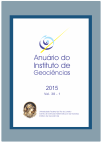The Application of the Universal Soil Loss Equation by Using Free and Available Softwares
DOI:
https://doi.org/10.11137/2015_1_170_179Keywords:
Erosion, Geotechnologies, gvSIG, QGISAbstract
Erosion is one of most serious form of soil degradation. In addition to reducing the productive potential of the soil, it can cause serious environmental damage such as pollution of the water resources, modifying the ecology of aquatic ecosystems and silting of watercourses. The Universal Soil Loss Equation (USLE) which estimates erosion under a variety of conditions like soil usage and soil coverage, slope, slope length, soil and rain types through the elaboration of thematic maps, is an important research tool on the erosion process and allows the partitioning of landscape instability levels. When applied through free software and free images, the costs for the study execution are reduced considerably. This study sought to map and to perform a qualitative analysis of the erosive susceptibility of the Paraíso das Águas city -- Mato Grosso do Sul state, Brazil, in 2013. The USLE mathematical model was applying by QGIS, gvSIG and LS-TOOLS softwares. The city obtained an average annual soil loss ranging from 0 to 1,307.32 ton/ha.year. Most part of the land, 91.94%, was classified as a low to moderate erosion since it has an erosive rate lower than 15 ton/ha.year. It was shown that the erosive dynamic was influenced mainly by land characteristics demonstrated through the topographical factor (LS).Downloads
Published
2017-02-15
Issue
Section
Article
License
This journal is licensed under a Creative Commons — Attribution 4.0 International — CC BY 4.0, which permits use, distribution and reproduction in any medium, provided the original work is properly cited.















 Except where otherwise noted, content on this site is licensed under a license
Except where otherwise noted, content on this site is licensed under a license 